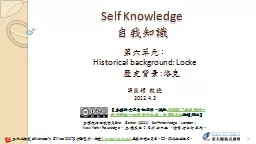/


自我 知識 第 六 單元 Historical background Locke 歷史背景 洛克 梁益堉 教授 201242 本著作除另有註明外採取 創用 CC 姓名標示非商業性相同方式分享台灣 ID: 541935
Download Presentation The PPT/PDF document "1 Self Knowledge" is the property of its rightful owner. Permission is granted to download and print the materials on this web site for personal, non-commercial use only, and to display it on your personal computer provided you do not modify the materials and that you retain all copyright notices contained in the materials. By downloading content from our website, you accept the terms of this agreement.
Slide1
1
Self Knowledge自我知識
第六單元:Historical background: Locke 歷史背景:洛克梁益堉 教授2012.4.2
【
本著作除另有註明外,採取創用CC「姓名標示-非商業性-相同方式分享」台灣3.0版授權釋出】
本課程指定教材為Brie Gertler (2011). Self-knowledge. London ; New York : Routledge。 本講義僅引用部分內容,請讀者自行準備。
本作品轉載自
Microsoft Office 2007多媒體藝廊,依據Microsoft服務合約及著作權法第46、52、65條合理使用。Slide2
Inner sense and personal identity
Personal identity: numerical identity not property identityLocke由inner sense theory內省來談PI
,person具自我意識,區別他人與自己,不同時空下是不是同一個人。P. 44 A person is a thinking intelligent being, that has reason and reflection, …, which it does only by that consciousness which is inseparable from thinking.From the inside,不是透過推論、從外部來察覺自己的心智狀態。P. 44 What makes a particular thought (or action) mine, on Locke’s theory, …,namely through inner sense or through memory “from the inside.”
2
以上著作轉載自Brie Gertler (2011). Self-knowledge. London ; New York : Routledge,頁44,依據著作權法第
46、52、65條合理使用。Slide3
Inner sense and personal identity
Locke effectively rejects that persons are individuated by the bodies they inhabit.同一個身體可以是不同的person
。Ex: 補鞋匠與王子。某個心智狀態是不是我的思維呢?Reading 1: A thought or action belongs to me insofar as I am conscious of it (through inner sense or memory), though I may not recognize it as mine.Reading 2: A thought or action belongs to me only insofar as I recognize it as mine, or appropriate it.What do you think?你確定是你在痛而不是別人在痛,是個合理的問題嗎?R 1:yes, R2: no.3Slide4
Inner sense and personal identity
According to Reading 1: 即使我沒察覺到那是
我的思維。透過內省,察覺到一個思維就蘊含察覺到那是我的思維。According to Reading 2: these belong to a single person if and only if these are appropriated by him, or recognized as belonging to his consciousness.對自我最基本的認識是有thought and sensation。有沒有身體就不那麼重要。What do you think? 4
Flickr
,作者:Chicago Art Department。Slide5
Minimal self-consciousness
One can be conscious of oneself-as-object, or one can be conscious of oneself-as-subject. It is the latter that makes self-consciousness fundamentally special.Distinction between self-as-subject and self-as-object.Self-as-object: My arm is broken. I have grown six inches. I am bleeding.
Example of self-as-object: a base-runner and a catcher collide at home plate. The catcher’s leg is gashed by the spikes on the base-runner’s shoes, even though the catcher doesn’t immediately feel any pain. Because their limbs are entangled, upon first seeing the wound, the catcher might not immediately recognize it as his. As they disentangle, the catcher comes to realize that it is he who is bleeding. My consciousness of self-as-object can be mistaken.5Slide6
Minimal self-consciousness
Self-as-subject: I am in pain. I have toothache. I see a canary. I am waving my arm.Every experience has a unique subject.Wittgenstein: “there is no question of recognizing a person when I say I have tooth-ache. To ask ‘are you sure it is you who have pains?’ would be nonsensical.”There is no possibility of a misidentification. If I have my usual access to my hunger, there is no room for the thought “Someone is hungry all right, but is it me?
When we introspectively grasp that there is pain, hunger, etc. we cannot be mistaken about the subject of experience.Shoemaker: Considered as self-as-subject, we are “immune to error through misidentification relative to the first-person pronouns” (IEM).6Slide7
反例:
The rubber hand illusion (RHI)Body ownershipproprioceptive
drift: most subjects judged (by proprioception) their real hand as located closer to the rubber hand, not where it really was.touch referral: the tactile sensations they felt were located on the rubber hand.Misrepresentation of body ownership: many subjects feel that the rubber hand is their hand.7Flickr,作者:dhammza
。Slide8
反例:
SomatoparaphreniaMental ownershipBottini
et al. (2002) describe a case of somatoparaphrenia. A woman (FB) reported that her left hand belonged to her niece and that she (FB) felt no tactile sensations there. FB, blindfolded, was told that her left hand will be touched; next the examiner touched the dorsal surface of her hand. Whenever this was done, FB said that she felt no tactile sensations.But when told that her niece’s hand will be touched, upon actually being touched, FB reported feeling tactile sensation.L & L (2011): In the latter case, FB misrepresented her tactile sensation as belonging to someone else.8Slide9
版權聲明
9頁碼
作品授權條件作者/來源
1-9
本作品轉載自
Microsoft Office 2007多媒體藝廊,依據Microsoft服務合約及著作權法第46
、
52、65條合理使用。2A person
...... inseparable from thinking.
本著作轉載自
Brie
Gertler
(2011). Self-knowledge. London ; New York :
Routledge
,頁
44
,依據著作權法第
46
、
52
、
65
條合理使用。
2
What makes a particular ……“from the inside.”
本著作轉載
自
Brie
Gertler
(2011). Self-knowledge. London ; New York :
Routledge
,頁
44
,依據著作權法第
46
、
52
、
65
條合理使用。
4
Flickr
,作者:
Chicago Art Department
。
本作品轉載自
http://www.flickr.com/photos/chicagoartdepartment/2423339575/sizes/m/in/photostream/
,瀏覽日期
2012/4/6
。本作品採取
創用
CC「姓名標示」2.0版授權釋出。7Flickr,作者:dhammza。本作品轉載自http://www.flickr.com/photos/dhammza/492882480/sizes/m/in/photostream/,瀏覽日期2012/4/6。本作品採取創用CC「姓名標示-非商業性-相同方式分享」2.0 版授權釋出。